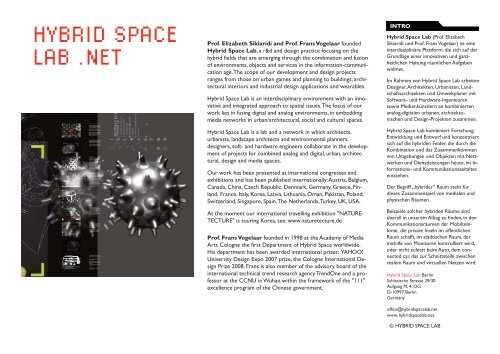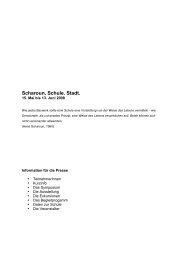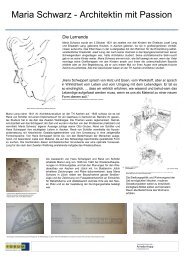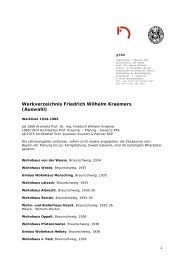Page 1 Hybrid Space Lab (Prof. Elizabeth Sikiaridi und Prof. Frans ...
Page 1 Hybrid Space Lab (Prof. Elizabeth Sikiaridi und Prof. Frans ...
Page 1 Hybrid Space Lab (Prof. Elizabeth Sikiaridi und Prof. Frans ...
Create successful ePaper yourself
Turn your PDF publications into a flip-book with our unique Google optimized e-Paper software.
<strong>Prof</strong>. <strong>Elizabeth</strong> <strong>Sikiaridi</strong> and <strong>Prof</strong>. <strong>Frans</strong> Vogelaar fo<strong>und</strong>ed<br />
<strong>Hybrid</strong> <strong>Space</strong> <strong>Lab</strong>, a r&d and design practice focusing on the<br />
hybrid fields that are emerging through the combination and fusion<br />
of environments, objects and services in the information-communication<br />
age. The scope of our development and design projects<br />
ranges from those on urban games and planning to buildings, architectural<br />
interiors and industrial design applications and wearables.<br />
<strong>Hybrid</strong> <strong>Space</strong> <strong>Lab</strong> is an interdisciplinary environment with an innovative<br />
and integrated approach to spatial issues. The focus of our<br />
work lies in fusing digital and analog environments, in embedding<br />
media networks in urban/architectural, social and cultural spaces.<br />
<strong>Hybrid</strong> <strong>Space</strong> <strong>Lab</strong> is a lab and a network in which architects,<br />
urbanists, landscape architects and environmental planners,<br />
designers, soft- and hardware engineers collaborate in the development<br />
of projects for combined analog and digital, urban, architectural,<br />
design and media spaces.<br />
Our work has been presented at international congresses and<br />
exhibitions and has been published internationally: Austria, Belgium,<br />
Canada, China, Czech Republic, Denmark, Germany, Greece, Finland,<br />
France, Italy, Korea, Latvia, Lithuania, Oman, Pakistan, Poland,<br />
Switzerland, Singapore, Spain, The Netherlands, Turkey, UK, USA.<br />
At the moment our international travelling exhibition "NATURE-<br />
TECTURE" is touring Korea, see: www.naturetecture.de<br />
<strong>Prof</strong>. <strong>Frans</strong> Vogelaar fo<strong>und</strong>ed in 1998 at the Academy of Media<br />
Arts Cologne the first Department of <strong>Hybrid</strong> <strong>Space</strong> worldwide.<br />
His department has been awarded international prizes: YAHOO!<br />
University Design Expo 2007 prize, the Cologne International Design<br />
Prize 2008. <strong>Frans</strong> is also member of the advisory board of the<br />
international technical trend research agency TrendOne and a professor<br />
at the CCNU in Wuhan within the framework of the "111"<br />
excellence program of the Chinese government.<br />
INTRO<br />
<strong>Hybrid</strong> <strong>Space</strong> <strong>Lab</strong> (<strong>Prof</strong>. <strong>Elizabeth</strong><br />
<strong>Sikiaridi</strong> <strong>und</strong> <strong>Prof</strong>. <strong>Frans</strong> Vogelaar) ist eine<br />
interdisziplinäre Plattform, die sich auf der<br />
Gr<strong>und</strong>lage einer innovativen <strong>und</strong> ganzheitlichen<br />
Haltung räumlichen Aufgaben<br />
widmet.<br />
Im Rahmen von <strong>Hybrid</strong> <strong>Space</strong> <strong>Lab</strong> arbeiten<br />
Designer, Architekten, Urbanisten, Landschaftsarchitekten<br />
<strong>und</strong> Umweltplaner mit<br />
Software- <strong>und</strong> Hardware-Ingenieuren<br />
sowie Medienkünstlern an kombinierten<br />
analog-digitalen urbanen, architektonischen<br />
<strong>und</strong> Design-Projekten zusammen.<br />
<strong>Hybrid</strong> <strong>Space</strong> <strong>Lab</strong> kombiniert Forschung,<br />
Entwicklung <strong>und</strong> Entwurf <strong>und</strong> konzentriert<br />
sich auf die hybriden Felder, die durch die<br />
Kombination <strong>und</strong> das Zusammenkommen<br />
von Umgebungen <strong>und</strong> Objekten mit Netzwerken<br />
<strong>und</strong> Dienstleistungen heute, im Informations-<br />
<strong>und</strong> Kommunikationszeitalter,<br />
entstehen.<br />
Der Begriff „hybrider“ Raum steht für<br />
dieses Zusammenspiel von medialen <strong>und</strong><br />
physischen Räumen.<br />
Beispiele solcher hybriden Räume sind<br />
überall in unserem Alltag zu finden, in den<br />
Kommunikationsräumen der Mobiltelefonie,<br />
die private Inseln im öffentlichen<br />
Raum schafft, im städtischen Raum, der<br />
mithilfe von Monitoren kontrolliert wird,<br />
oder nicht zuletzt beim Auto, dem connected<br />
car, das zur Schnittstelle zwischen<br />
realem Raum <strong>und</strong> virtuellen Netzen wird.<br />
<strong>Hybrid</strong> <strong>Space</strong> <strong>Lab</strong> Berlin<br />
Schlesische Strasse 29/30<br />
Aufgang M, 4. OG<br />
D-10997 Berlin<br />
Germany<br />
office@hybridspacelab.net<br />
www. hybridspacelab.net<br />
© HYBRID SPACE LAB
office@hybridspacelab.net<br />
DIY PAVILION<br />
BUILD YOUR OWN PAVILION 2010<br />
a flexible mobile exhibition platform<br />
The exhibition pavilion “Winter-worm<br />
Summer Herb” consists of triangular<br />
plywood plates sown together with the<br />
help of cable binders. At a very low cost<br />
and low technology construction the<br />
pavilion is also a flexible mobile structure<br />
that can be very easily disassembled,<br />
transported, reassembled and sown<br />
together again, adjusting to the size of the<br />
site and the local requirements.<br />
It was first presented at the waterfront<br />
promenade of Hong Kong within the<br />
framework of the Hong Kong & Shenzhen<br />
Bi-city Biennale of Urbanism and Architecture<br />
2009-2010. After the closing of<br />
the Biennale the pavilion was set up at the<br />
Hong Kong Jockey Club Creative Arts<br />
Centre (March-April 2010) and at the<br />
Kwai Tsing Theatre in Hong Kong (May<br />
2010), to travel afterwards as a mobile<br />
exhibition space aro<strong>und</strong> mainland China.<br />
Curator: Andrew Lam, MOST<br />
Photo Credits: Andy Tam<br />
© HYBRID SPACE LAB
office@hybridspacelab.net<br />
DIY PAVILION<br />
BUILD YOUR OWN PAVILION 2010<br />
a flexible mobile exhibition platform<br />
The pavilion as a flexible platform for<br />
community education: Videos on urban<br />
issues are projected on the triangular<br />
crystalline structure of the pavilion's<br />
interior.<br />
The pavilion, as a mobile and flexible platform,<br />
transgresses bo<strong>und</strong>aries, infecting its<br />
urban surro<strong>und</strong>ings by moving to a series<br />
of different locations for community<br />
education.<br />
Curator: Andrew Lam, MOST<br />
Photo Credits: Andy Tam<br />
© HYBRID SPACE LAB
1.1 What is <strong>Hybrid</strong> <strong>Space</strong> <strong>Lab</strong>?<br />
<strong>Frans</strong> Vogelaar (FV): <strong>Hybrid</strong> <strong>Space</strong> <strong>Lab</strong> is an interdisciplinary environment<br />
characterized by an innovative and integrated approach<br />
to spatial issues. It specializes in strategic research and high-end<br />
design. It is an R&D and design practice that focuses on the hybrid<br />
fields that are emerging through the combination and fusion of<br />
environments, objects and services in the information/communication<br />
age. "<strong>Hybrid</strong>" stands for our strategy of combining fields,<br />
"<strong>Space</strong>" reflects our expertise and "<strong>Lab</strong>" stands for our innovative<br />
and experimental approach. Our web address ends in ".net", suggesting<br />
our working practice of involving a network of specialists.<br />
1.2 What concept does the name reflect?<br />
<strong>Elizabeth</strong> <strong>Sikiaridi</strong> (ES): Mixing fields and combining expertise's and<br />
considering environments in their multiplicity of dimensions is for<br />
us a method for finding new relevant solutions to increasingly<br />
complex spatial design challenges. We investigate actual developments<br />
in the general fields of culture, communication, production,<br />
exchange (markets) as well as technological innovations, not to<br />
foremost monitor market development but in order to generate<br />
visions.<br />
FV: The starting point and spearhead of our work lie in the fusing<br />
of digital and analog environments, in embedding media networks<br />
in urban, architectural, social and cultural space. Our environments<br />
are today being rapidly transformed by medialization - and hence<br />
globalization. Today's technological developments are accelerated<br />
by the fusions of information technology, nanotechnology, biotechnology<br />
and neurotechnologies (brain technologies) and their convergence<br />
into new hybrid technology platforms such as DNA<br />
computing, nanobiotechnology, synthetic biology and neuroengineering...<br />
FV: We approach these technological developments from<br />
the perspective of the designer, the architect and the<br />
urbanist, by "inhabiting technology", by transforming<br />
these technological developments to meet the way we<br />
want to live.<br />
ES: Innovation is not a goal in itself, but a means of coping with and<br />
steering developments. <strong>Hybrid</strong>ization is an evolutionary strategy to<br />
develop new solutions for the changing environments in our fastmoving<br />
world. I remember an early reading of an essay entitled<br />
"Race and History" that Claude Lévi-Strauss wrote for UNESCO<br />
in 1952. Lévi-Strauss contrasts cumulative, dynamic, "moving<br />
cultures" with "static", non-developing cultures and argues that<br />
intercultural connections and cross-fertilization are crucial to the<br />
development of differentiated civilizations.<br />
1.3 What kind of projects do you work on and initiate?<br />
FV: <strong>Hybrid</strong> <strong>Space</strong> <strong>Lab</strong> is a lab and a network in which designers,<br />
architects, urbanists, landscape architects, environmental planners,<br />
software and hardware engineers, and media artists collaborate to<br />
develop projects for combined analog and digital, urban, architectural,<br />
design and media spaces. The relationship of digital service<br />
environments and artifacts to our architectural and urban surro<strong>und</strong>ings<br />
and objects is central to our strategic research and design<br />
agenda. The research and development projects range from<br />
urban games and urban planning to buildings, architectural interiors<br />
and industrial design applications and wearables.<br />
ES: We also have a long track record in consultancy; we were part<br />
of a think tank for the Dutch government and have advised corporations,<br />
local authorities, and cultural, educational and research institutes.<br />
We developed the project idea for the Urban Dinners on<br />
the main highway of the Ruhr region for the RUHR.2010 Cultural<br />
Capital organization. Our working method is to merge analytical<br />
investigations with synthetic design processes. We apply Design<br />
Thinking to a very extensive range of issues and fields.<br />
INTERVIEW<br />
Interview by Inga Wellman, published<br />
in „Governance der Kreativwirschaft“,<br />
Bastian Lange, Ares Kalandides, Birgit<br />
Stöber & Inga Wellman (editors),<br />
transcript, 2009.<br />
<strong>Hybrid</strong> <strong>Space</strong> <strong>Lab</strong> Berlin<br />
Schlesische Strasse 29/30<br />
Aufgang M, 4. OG<br />
D-10997 Berlin<br />
Germany<br />
office@hybridspacelab.net<br />
www. hybridspacelab.net<br />
© HYBRID SPACE LAB
FV: We work internationally. At the moment we are busy with a<br />
project for the Tschumi Pavilion Fo<strong>und</strong>ation in Groningen in the<br />
Netherlands, consisting of a programmatic plan, a business plan,<br />
an urban strategy and an architectural design for a new Media and<br />
Performing Arts Centre. We are also in the final stages of a project<br />
for the Torino World Design Capital 2008, geared to security in<br />
public space – politically, a heavily abused issue in Italy. Our approach<br />
is based on the appropriation of public space by proposing<br />
and designing a series of services that strengthen and encourage<br />
public involvement in the open spaces of the city. Last but not least,<br />
we are curating an international touring exhibition on cityscape<br />
and sustainability and designing a "Media Camp" due to be built in<br />
Shenzen by the end of 2009.<br />
2. Where does the <strong>Hybrid</strong> <strong>Space</strong> <strong>Lab</strong> come from (your backgro<strong>und</strong><br />
story/out of what need did you set the gro<strong>und</strong> for the HSL),<br />
ES: <strong>Frans</strong> studied industrial design and architecture and urbanism; I<br />
studied architecture and urbanism. Before setting up our practice<br />
we had already gained professional experience in many different<br />
fields, including architecture (OMA/Rem Koolhaas, Behnisch & Pa.);<br />
industrial design (Studio Alchemia/Allessandro Mendini); and<br />
fashion (trend research in Paris), as well as urbanism; landscape<br />
architecture and urbanism; material design, food design and exhibition<br />
design; interior architecture; media design...<br />
We both have hybrid cultural backgro<strong>und</strong>s and have lived and<br />
worked internationally: I was born in London, grew up in Athens,<br />
studied at the École d'Architecture de Belleville in Paris and at the<br />
Technical University of Darmstadt. <strong>Frans</strong> was born in the Netherlands,<br />
grew up in Zimbabwe, studied at the Design Academy in<br />
Eindhoven and at the Architectural Association School of Architecture<br />
(AA) in London.<br />
FV: We were aware from early on that the ICT developments, the<br />
"rise of a network society" as Manuel Castells puts it, would have<br />
an immense impact on the way we live and work, accelerating<br />
globalization, the flexibilization of lifestyles and the development of<br />
the creative economy. The new production and communication<br />
tool of the networked computer provides a common working instrument<br />
for a broad range of creative professions. It is also transforming<br />
creative processes and products and paving the way for a<br />
series of hybrid professional fields.<br />
ES: At first, when people were thinking in terms of the polarity of<br />
media and physical space, it was difficult to communicate our<br />
'hybrid space' approach, which considers the physical environment<br />
in the context of and in relation to the networks that it belongs to<br />
and interacts with. We started with self-initiated artistic research<br />
projects. These led to consultancies and research and development<br />
and design assignments.<br />
3.1 Where do you locate yourself within the broader context of<br />
the creative economy?<br />
ES: The creative economy is, by definition, dynamic. The traditional<br />
disciplines will develop, transform, mutate, fuse. We see our '<strong>und</strong>isciplined'<br />
laboratory as a catalyst in this process and as a<br />
space for development and experimentation.<br />
3.2 What are your strategies in overcoming outdated structures or<br />
practices?<br />
FV: When we started, we did have a communication problem as we<br />
did not fit neatly into the predefined territory of the distinct disciplines.<br />
We were repeatedly asked "What exactly are you?<br />
Designers, architects, urbanists, landscape urbanists, researchers...<br />
or media artists?" We responded with an offensive strategy,<br />
by defining our office as a hybrid laboratory.<br />
4. What definition or interpretation of the „hybrid“ do you feel is<br />
of relevance for contemporary phenomena in the economical, social<br />
and cultural sphere?<br />
INTERVIEW<br />
Interview by Inga Wellman, published<br />
in „Governance der Kreativwirschaft“,<br />
Bastian Lange, Ares Kalandides, Birgit<br />
Stöber & Inga Wellman (editors),<br />
transcript, 2009.<br />
<strong>Hybrid</strong> <strong>Space</strong> <strong>Lab</strong> Berlin<br />
Schlesische Strasse 29/30<br />
Aufgang M, 4. OG<br />
D-10997 Berlin<br />
Germany<br />
office@hybridspacelab.net<br />
www. hybridspacelab.net<br />
© HYBRID SPACE LAB
ES: In the times of the Aristotelian categories, the notion of the<br />
"hybrid", the crossbreed, had a negative connotation. Today the<br />
notion of the "hybrid" is everywhere. <strong>Hybrid</strong>ization is becoming an<br />
increasingly important issue in the cultural field. Look at the attention<br />
paid to world literature; think of the 2008 Nobel Price for<br />
Literature. Today, you have hybrid cars, hybrid businesses, hybrid<br />
securities, hybrid plastics, hybrid plants, hybrid pigs... all reflecting<br />
a cultural shift away from a mindset based on clear-cut categories<br />
towards a flexible approach based on intermixtures, on interconnections<br />
and networks.<br />
FV: <strong>Hybrid</strong> space is everywhere in our daily lives. Take, for example,<br />
the private (communication) space of mobile telephony, which<br />
creates islands of private space within public urban space. Or<br />
monitored environments, where cameras keep watch over open<br />
areas. The tele-workplace is becoming an integral part of the home,<br />
the office is becoming a space for encounters, with a meeting<br />
lounge atmosphere, the (connected) car is becoming a mobile extension<br />
of our networked existence, to name only a few examples.<br />
ES: "<strong>Hybrid</strong>" defined as the combination – the fusion – of the analog<br />
and the digital is a good starting point. As <strong>Frans</strong> just mentioned,<br />
medialization and globalization are transforming space, activities<br />
and professional fields. <strong>Hybrid</strong> retail, integrating e-commerce and<br />
physical stores, changes the shop into the experiential space of the<br />
"point of sale". <strong>Hybrid</strong> publishing is closely entwined with citizen<br />
journalism. In new business models customers are co-creating and<br />
co-developing products. Think of the Lego Digital Designer that<br />
enables users to create, share and improve the design of the building<br />
brick toys.<br />
FV: The days when people were defined by their profession and remained<br />
with the same employer and in the same professional field<br />
throughout their working life belong in the past.<br />
FV: Together with my students at the Academy of Media Cologne<br />
we are developing strategies for "hybrid practice". The aim is to<br />
generate new practice models for the multi-job strategies and the<br />
patchwork biographies of the "project workers" of today and<br />
tomorrow.<br />
5. In the past, who and what were the forerunners and idols of<br />
today’s hybrid practice?<br />
ES: One of the pioneers was the Greek and French music composer,<br />
media artist, architect and engineer Iannis Xenakis (1922-<br />
2001). In the 1990’s we worked with Xenakis in his personal<br />
archives in Paris and interviewed him on his work and artistic concepts.<br />
What is interesting about Xenakis is the way he implemented<br />
structures in different fields and transferred them from<br />
one field to another: from engineering and mathematical-scientific<br />
research to music, from music to architecture and to visual events.<br />
Xenakis worked on the "poetics of the electronic age" and on a<br />
general discipline of form, a "General Morphology", integrating the<br />
new, universal, electronic tools of the computer in his artistic<br />
oeuvre.<br />
FV: Another pioneer is the American designer, architect, author and<br />
visionary inventor, Richard Buckminster Fuller (1895-1983), who<br />
was deeply concerned with sustainability issues.<br />
6. And, with regard to the book title, what do you consider important<br />
for the governance of the creative economy?<br />
ES: It is important to reflect on and discuss these themes. We still<br />
need to develop not only working business models for the creative<br />
sector but also social strategies to support the sustainable<br />
development of a creative society and economy.<br />
FV: We believe that it is important to strengthen the interdisciplinary<br />
networking platforms and support creative environments of<br />
encounter because they foster innovation. One cannot <strong>und</strong>erestimate<br />
the strategic value of cross-over spaces and<br />
hybrid laboratories.<br />
INTERVIEW<br />
Interview by Inga Wellman, published<br />
in „Governance der Kreativwirschaft“,<br />
Bastian Lange, Ares Kalandides, Birgit<br />
Stöber & Inga Wellman (editors),<br />
transcript, 2009.<br />
<strong>Hybrid</strong> <strong>Space</strong> <strong>Lab</strong> Berlin<br />
Schlesische Strasse 29/30<br />
Aufgang M, 4. OG<br />
D-10997 Berlin<br />
Germany<br />
office@hybridspacelab.net<br />
www. hybridspacelab.net<br />
© HYBRID SPACE LAB









